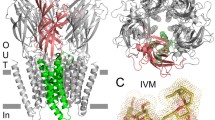Abstract
The effects of K+ on muscle contractility were explored in the filarial nematodeAcanthocheilonema viteae (Dipetalonema viteae). The parasite was slit open longitudinally and mounted in a smooth muscle chamber that was filled with aerated (95% N2−5% CO2) physiological solution at 37°C. KCl at concentrations ranging from 20 to 100 mM induced a rapid isotonic contraction of the filarial muscle. The maximal response from KCl was similar to the maximal response to acetylcholine chloride (ACh). When KCl was applied for several minutes, tolerance frequently occurred. Contractions were also induced by K2SO4 but not by NaCl, Na2SO4 or sucrose. Nifedipine was more than 10 times as potent in reducing the KCl-induced contraction as in reducing that caused by ACh. The KCl-induced contraction was abolished in a Ca-free physiological medium containing ethyleneglycol-bis-(β-aminoethyl ether)N,N,N′,N′-tetraacetic acid (EGTA, 10−4 M). Low [Ca2+]/[Mg2+] solutions blocked the spontaneous activity, the KCl-induced contractions, and the ACh-induced contractions. KCl also induced contractions in denervated muscle strips, supporting the hypothesis that K+ acts directly on the muscle cells. These results indicate that K+ can depolarize the muscle membrane and induce a muscle contraction that is dependent on extracellular calcium ions.
Similar content being viewed by others
References
Adrian RH (1956) The effect of internal and external potassium concentration on the membrane potential of frog muscle. J Physiol (Lond) 133: 631–658
Almers W, McCleskey EW, Palade PT (1985) Calcium channels in vertebrate skeletal muscle. In: Rubin RP, Weiss GB, Putney JW (eds) Calcium in biological systems. Plenum, New York, pp 321–330
Brading AF, Caldwell PC (1971) The resting membrane potential of the somatic muscle cells ofAscaris lumbricoides. J Physiol (Lond) 217: 605–624
Christ D, Stillson T (1992) Effects of calcium channel blockers on the contractility of the filariidAcanthocheilonema viteae. Parasitol Res 78: 489–494
Christ D, Goebel M, Saz HJ (1990) Actions of acetylcholine and GABA on spontaneous contractions of the filariid,Dipetalonema viteae. Br J Pharmacol 101: 971–977
Christ D, Oh J, Saz HJ (1991) Contractions ofAcanthocheilonema viteae induced by potassium chloride. Am Soc Parasitol Abstr p. 86
Christ D, Cabel J, Saz HJ (1993) Contractions induced by ouabain in the filariid,A. viteae. FASEB J 7: A223
Del Castillo J, Engbaek L (1954) The nature of the neuromuscular block produced by magnesium. J Physiol (Lond) 124: 370–384
Del Castillo J, De Mello WC, Morales T (1964) Influence of some ions on the membrane potential ofAscaris muscle. J Gen Physiol 48: 129–140
Franke ED, Weinstein PP (1984) In vitro cultivation ofDipetalonema viteae third stage larvae: evaluation of culture media, serum and other supplements. J Parasitol 70: 618–628
Godfraind T, Miller R, Wibo M (1986) Calcium antagonism and calcium entry blockade. Pharmacol Rev 38: 321–416
Hodgkin AL, Horowicz P (1959) The influence of potassium and chloride ions on the membrane potential of single muscle cells. J Physiol (Lond) 148: 127–160
Katz B, Miledi R (1967) The timing of calcium action during neuromuscular transmission. J Physiol (Lond) 189: 535–544
Martin RJ (1982) Electrophysiological effects of piperazine and diethylcarbamazine onAscaris suum somatic muscle. Br J Pharmacol 77: 255–265
Rohrer WH, Esch H, Saz HJ (1988) Neuromuscular electrophysiology of the filarial helminthDipetalonema viteae. Comp Biochem Physiol C 91: 517–523
Rosenbluth J (1965) Ultrastructure of somatic muscle cells inAscaris lumbricoides II. Intermuscular junctions, neuromuscular junctions, and glycogen stores. J Cell Biol 26: 579–591
Weisblat DA, Russell RL (1976) Propagation of electrical activity in the nerve cord and muscle syncytium of the nematodeAscaris lumbricoides. J Comp Physiol 107: 293–307
Author information
Authors and Affiliations
Rights and permissions
About this article
Cite this article
Christ, D., Oh, J. & Saz, H.J. Contractions of the filariidAcanthocheilonema viteae induced by potassium chloride. Parasitol Res 80, 449–453 (1994). https://doi.org/10.1007/BF00932689
Received:
Accepted:
Issue Date:
DOI: https://doi.org/10.1007/BF00932689




